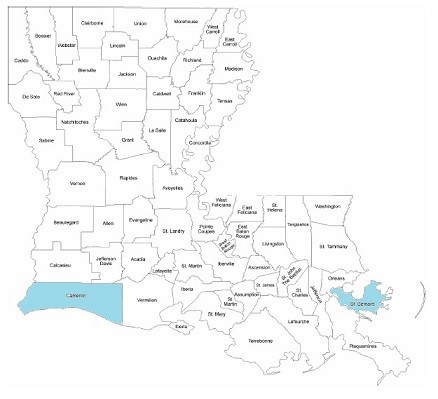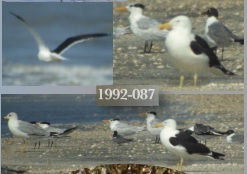

A pair of adults (89-173) on 8 Jul 1989, St. Bernard: Breton NWR, Chandeleur Islands, Curlew Island; R. D. Purrington and Lawrence O’Meallie (ph). This is the first record of Kelp Gull for Louisiana and the United States. The record was initially submitted as Lesser Black-backed Gull, which received a non-accept vote on the first circulation; the record was subsequently re-submitted (Dittmann) and accepted as Kelp Gull.
Photo by Lawrence O'Meallie
One adult (90-45), paired to a Herring Gull and accompanied by a full-grown fledgling, on 31 Jul 1990, St. Bernard: Breton NWR, Chandeleur Islands, North Gosier Island; Richard Martin (ph). This represents the second state record of Kelp Gull and the first confirmed breeding of Herring and Kelp gulls for Louisiana.
After the Committee agreed that the identification of the "black-backed gulls" on the Chandeleur Islands was consistent with Kelp Gull, the issue of origin remained a concern. The Committee wrestled with how best to deal with the status of this species in Louisiana, because their appearance in the Gulf of Mexico was coincidental with an importation of eggs and subsequent distribution of captive bred birds by Sea World, Inc. (Dittmann and Cardiff 1998). Recent records of Kelp Gulls on the coasts of Texas (Texas Bird Records Committee reports), the Yucatan Peninsula (Howell et al. 1993), and Trinidad (Hayes et al. 2000), suggest that range expansion into the Gulf-Caribbean region may be in progress. Additionally, in the eastern Atlantic, the species has moved up the coast of West Africa to Senegambia (Urban et al. 1986) and Mauritania (Pineau et al. 2001; interestingly, Kelp Gulls reaching Mauritania have been reported to hybridize with Yellow-legged Gull [Larus michahellis]), and, in the Pacific, the species has extended its breeding range north to Ecuador (Haase 1996); there is also a recent record from Christmas Island in the central Pacific Ocean (H. Lee Jones, ms in prep). The Committee ultimately decided that, in light of recent patterns of vagrancy and range expansion, natural origin was much more plausible than a convoluted scenario based on escape of multiple captive-bred individuals and their subsequent breeding in the Gulf of Mexico.
One adult in breeding plumage (1992-087) on 5 June 1992, Cameron: ca 2 mi. W old mouth Mermentau River (Rutherford
Beach); John P. Sevenair, Curtis C. Sorrells, Phillip A. Wallace (ph), and Alfred E. and Gwen B. Smalley (ph). This record was initially submitted as a Great Black-backed Gull and then as a Yellow-footed Gull, neither of which were accepted. Records certainly pertained to the same bird, which was eventually re-identified as a Kelp, circulated as such, and accepted.

Photos by Gwen B. Smalley
One adult in breeding plumage (1992-088) on 13 June 1992, Cameron: ca 8 mi. W old mouth Mermentau River (Rutherford Beach); Joseph P. Kleiman. This record, originally submitted as a Lesser Black-backed Gull, was accepted as a Kelp Gull based on the description, combined with date and location, and almost certainly represented the same bird as 1992-87.
One adult (1994-037) on 26 June 1994, St. Bernard: Chandeleur Islands, Breton-Delta National Wildlife Refuge, Curlew Island; Charlotte Seidenberg (ph). Photos also document another adult dark-mantled gull, which was first hypothesized by D. L. Dittmann as a Kelp X Herring hybrid.
Four, three definitive adults and a third-year (1994-115) on 23-24 July 1994, St. Bernard: Chandeleur Islands, Breton-Delta National Wildlife Refuge, Curlew Island; Donna L. Dittmann and Steven W. Cardiff (ph), and Charles E. Lyon (ph).
One adult (1995-037) on 8 August 1995, St. Bernard: Chandeleur Islands, Breton-Delta National Wildlife Refuge, Curlew Island; John P. Sevenair. No photos or video submitted.
Two adults (1997-093) on 17 June 1997, St. Bernard: Chandeleur Islands, Breton-Delta National, one offshore between Freemason and Curlew islands, and one on Curlew Island; Donna L. Dittmann. The Curlew individual was paired to a hybrid Kelp X Herring gull.
One fourth year/adult male (1998-128) on 9 June 1998, St. Bernard: Chandeleur Islands, Breton-Delta NWR, South Gosier Island; Steven W. Cardiff (LSUMZ 165987) and Donna L. Dittmann (DLD 6144, ph). This is the first and only specimen for Louisiana and North America. The genetic identity of this individual was confirmed by Pierre André Crochet (mtDNA cytB) and Sarah A. Sonsthagen (mtDNA control region and nuclear introns).
Two adult females (1998-111) on 9-10 June and 13-14 July 1998, St. Bernard: Chandeleur Islands, Breton-Delta National Wildlife Refuge, Curlew Island; Donna L. Dittmann and Steven W. Cardiff>. These individuals were both paired, one to a hybrid Kelp X Herring Gull, and one to an apparent pure Herring Gull.
Two adults (1999-021) on 17 April 1999, Gulf of Mexico: 15 mi. S Port Fourchon; Donna L. Dittmann and Steven W. Cardiff, R. Martin Guidry (ph), Robert D. Purrington, Curtis A. Marantz, John P. Sevenair (ph), and Phillip A. Wallace (ph only). A third bird present and photographed was identified as an F1-type Kelp X Herring hybrid. This is the only accepted record of Kelp Gull from Louisiana’s offshore waters.
One fourth year male (1999-108) on 11 June 1999, St. Bernard: Chandeleur Islands, Breton-Delta National Wildlife Refuge, Curlew Island fragment; Donna L. Dittmann and Steven W. Cardiff (ph).
One second year immature (1999-134) on 7 September 1999, St. Bernard: Chandeleur Islands, Breton-Delta National Wildlife Refuge, north Curlew Island sand bar; D. L. Dittmann and Steven W. Cardiff.
One adult male (2000-104) on 2 August 2000, St. Bernard: Chandeleur Islands, Breton-Delta National Wildlife Refuge, Curlew Island; Donna L. Dittmann and Steven W. Cardiff.
See also Origins and Identification of Kelp x Herring Gull Hybrids: The ‘Chandeleur Gull’, by Donna L. Dittmann & Stephen W. Cardiff (from Birding, May/June 2005, pp. 266–276.
One molting adult (1996-084) on 28 April 1996, Cameron: Broussard Beach. This was an interesting bird, initially assumed to be the same Kelp Gull that had recently been observed at Galveston, TX and reported to have a black mantle and greenish-colored legs. However, this bird was also seen by two of the Committee Members, who reported size, leg color (grayish ivory), and mantle color better supported identification as a Great Black-backed Gull or Great Black-backed hybrid.
One adult or 3rd winter (1996-047) on 12 October 1996, Lafourche: Fourchon Beach about 1 ½-2 mi. ENE from end of road (photos). All Members believed that a hybrid X Herring Gull was not eliminated by the description or the photograph.
One adult (1997-056) on 13 September 1997, Plaquemines: approx. 8 mi. N of SW Pass of Mississippi River (photos, sketch). All Members believed that a hybrid Kelp Gull X Herring Gull or some other hybrid combination was not eliminated by the description.